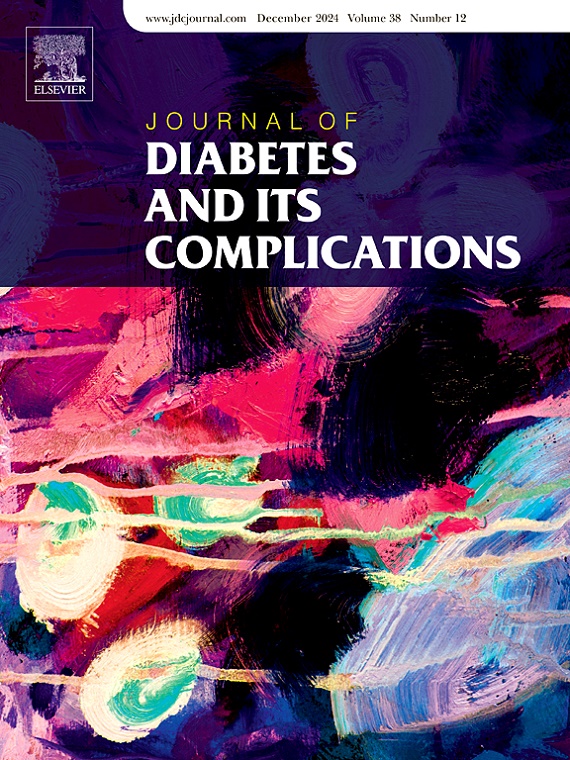1型糖尿病存在心血管自主神经病变的临床风险评分的外部验证
IF 3.1
3区 医学
Q3 ENDOCRINOLOGY & METABOLISM
引用次数: 0
摘要
目的在独立的外部人群中验证先前在1型糖尿病(T1D)中开发的CAN风险评分,并验证心血管自主神经病变(CAN)具有良好的诊断准确性。方法47例T1D患者(年龄47.7±13.2岁,糖尿病病程30.0(19.0 ~ 40.5)年,男性24例)行4次心血管反射试验(cart),早期诊断并确诊CAN(根据1或2次异常结果)。CAN风险评分根据静息心率、HbA1c、视网膜病变和/或肾病、心血管疾病、高密度脂蛋白胆固醇、收缩压和吸烟(范围0-10)计算。结果6例(23.4%)患者有CAN。整体CAN(早期和确诊)和确诊CAN (P = 0.0142)患者的CAN风险评分高于无CAN者(P = 0.0498),且与cart严重程度(rho = 0.32, P = 0.026)、呼气/吸气比(r = - 0.33, P = 0.0258)和Valsalva比(r = - 0.47, P = 0.0015)相关。19名参与者的CAN风险评分≥4分,与确诊的CAN存在相关(P = 0.0129)。确诊CAN的ROC曲线下面积(AUC)为0.802±0.080,截止值为4时,敏感性、特异性和阴性预测值分别为85.71%、67.50%和96.43%。本研究证实了CAN风险评分的诊断价值,并支持将其纳入诊断算法,以确定cart的候选患者,从而减少普遍筛查。使用常规可用的临床数据作为分类变量,该评分易于计算和在临床设置中实施。本文章由计算机程序翻译,如有差异,请以英文原文为准。
External validation of a clinical risk score for the presence of cardiovascular autonomic neuropathy in type 1 diabetes
Aims
To validate in an independent external population a CAN Risk Score previously developed in type 1 diabetes (T1D) and validated for cardiovascular autonomic neuropathy (CAN) with a good diagnostic accuracy.
Methods
Forty-seven participants with T1D (age 47.7 ± 13.2 years, duration of diabetes 30.0 (19.0–40.5) years, 24 males) underwent 4 cardiovascular reflex tests (CARTs) to diagnose early and confirmed CAN (according to 1 or 2 abnormal results). CAN Risk Score was calculated from resting heart rate, HbA1c, retinopathy and/or nephropathy, cardiovascular disease, HDL cholesterol, systolic blood pressure and smoking (range 0–10).
Results
Eleven participants (23.4 %) had CAN. The CAN Risk Score was higher in subjects with overall CAN (early and confirmed) (P = 0.0498) and with confirmed CAN (P = 0.0142) compared to those without, and correlated with CARTs severity (rho = 0.32, P = 0.026), Expiration/Inspiration ratio (r = −0.33, P = 0.0258) and Valsalva ratio (r = −0.47, P = 0.0015). A CAN Risk Score ≥ 4 was found in 19 participants and was associated with the presence of confirmed CAN (P = 0.0129). The CAN Risk Score showed an area under the ROC curve (AUC) of 0.802 ± 0.080 for confirmed CAN, and at the cut-off of 4, sensitivity, specificity and negative predictive values of 85.71 %, 67.50 % and 96.43 %.
Conclusions
This study confirmed the diagnostic value of the CAN Risk Score and supports its inclusion in a diagnostic algorithm to identify candidates for CARTs, thereby reducing universal screening. Using routinely available clinical data as categorical variables, the score is easy to calculate and implement in clinical settings.
求助全文
通过发布文献求助,成功后即可免费获取论文全文。
去求助
来源期刊

Journal of diabetes and its complications
医学-内分泌学与代谢
CiteScore
5.90
自引率
3.30%
发文量
153
审稿时长
16 days
期刊介绍:
Journal of Diabetes and Its Complications (JDC) is a journal for health care practitioners and researchers, that publishes original research about the pathogenesis, diagnosis and management of diabetes mellitus and its complications. JDC also publishes articles on physiological and molecular aspects of glucose homeostasis.
The primary purpose of JDC is to act as a source of information usable by diabetes practitioners and researchers to increase their knowledge about mechanisms of diabetes and complications development, and promote better management of people with diabetes who are at risk for those complications.
Manuscripts submitted to JDC can report any aspect of basic, translational or clinical research as well as epidemiology. Topics can range broadly from early prediabetes to late-stage complicated diabetes. Topics relevant to basic/translational reports include pancreatic islet dysfunction and insulin resistance, altered adipose tissue function in diabetes, altered neuronal control of glucose homeostasis and mechanisms of drug action. Topics relevant to diabetic complications include diabetic retinopathy, neuropathy and nephropathy; peripheral vascular disease and coronary heart disease; gastrointestinal disorders, renal failure and impotence; and hypertension and hyperlipidemia.
 求助内容:
求助内容: 应助结果提醒方式:
应助结果提醒方式:


